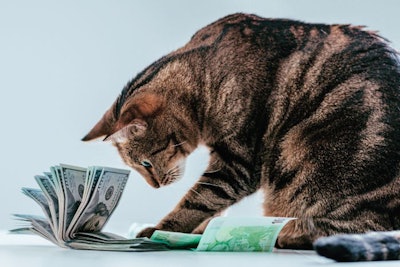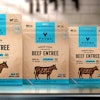
At the end of 2021, pet food inflation in the U.S. stood at only 2.4%: higher than 2020 but lagging well behind the overall U.S. inflation rate of 7%, as well as that of other sectors. Yet we all know inflation has not only continued into 2022 but also worsened. Is that true for pet food, too?
In short, yes. At the end of February 2022, U.S. pet food inflation reached 3.7%, according to data from the U.S. Bureau of Labor Statistics reported and analyzed by John Gibbons on PetBusinessProfessor.com. That’s still well below the 7.9% rate for the overall U.S. economy in February and also the 8.6% for human food (or “food at home,” not including eating out). But it’s obvious that pet food is not immune to the disruptions and inflationary pressures affecting most sectors of the economy.
Pet food inflation is lowest amid overall pet care market
In his analysis, Gibbons provided a chart of monthly inflation rates since December 2019, pointing out that early 2021 was actually deflationary for pet food, so January and February 2022 were bound to show an increase. However, the 3.7% inflation rate in February, following 1.1% in January 2022, is more than double the pre-pandemic increase for pet food from 2018 to 2019, Gibbons wrote.
For the entire 24-month period tracked, U.S. pet food inflation hit 5.4%. The overall U.S. pet care market was nearly double, at 9.5% (5.5% for February 2022 alone), and pet and veterinary services were even higher, at 11.7% and 14.6%, respectively, for the 24-month period and 6.5% and 7.5%, respectively, for February 2022. The 24-month inflation for pet supplies was comparable to that of pet food, at 5.8%, but the February jump was 7.5%, possibly portending even worse inflation for that sector in the months ahead.
Human food inflation worse, consumers are concerned
Despite the rising inflation rates for the pet care and pet food markets, other industries in the U.S. are faring much worse, with inflation even higher than for the overall economy. For example, inflation over the 24-month period since December 2019 for food at home has risen to 13.4%, no doubt spurred by that 8.6% increase in February 2022 alone. For personal services for people, such as haircuts, the 24-month inflation rate has soared to 15.1%, though the February rate of 5.6% was not as bad.
Those varying rates reflect the current pain points in supply chains, with prices for many food items noticeably higher now. In a survey of 2,200 consumers conducted in mid-February for the New York Times by Morning Consult, almost 90% of respondents said they’ve noticed rising prices for many goods, not just foods. The least surprising mention—with the highest number, at 904 mentions—was for gas, which only keeps getting more expensive with the invasion of Ukraine and resulting sanctions against Russia.
Yet common food items such as milk, meat, beef, chicken and eggs also all received triple-figure mentions; the article accompanying the data, written by Emily Badger, Aatish Bhatia and Quoctrung Bui, said food was mentioned by more than 90% of respondents, despite the fact that it comprises only about 13% of most household purchasing.
Still, dozens of different types of products and purchases were mentioned, even ones like houses, at 39 mentions. Items like clothing, beer and toilet paper showed up with 75, 64 and 63 mentions, respectively.
And pet food made the list: 27 respondents mentioned dog food, 18 mentioned pet food in general, and 16 mentioned pet food. The article included this quote from a respondent: “The price of pet food is hard to even fathom.”
Risks ahead for pet food?
That some consumers are feeling the pain of rising pet food prices is likely due, at least in part, to pet food’s close link to human food; consumer concern over the rapidly rising prices for the latter may well spill over into what they’re paying to feed their furry family members, too.
Yet it may also reflect the risk that there’s a limit to just how much even the most devoted pet owners will pay for their pets’ food, despite the market’s reputation for being resilient, even recession-proof. Market watchers like Bryan Jaffe, manager director of investment firm Cascadia Capital, have been warning since last fall that supply chain disruptions and increasing inflation could curtail future industry growth. “We have underestimated pet owners in the past, but these are unprecedented times,” he said.
And, new data from Packaged Facts and MRI-Simmons show that increases in pets adopted or acquired during the pandemic, followed by a rise in pet care spending, were driven by higher-income households. Further, the gains were offset by losses—in the form of pet relinquishment/lower pet ownership as well as lower pet spending—among lower-income households. (Watch for that data and more information in the April issue of Petfood Industry, as well as in a Petfood Forum 2022 presentation on May 3 by David Sprinkle, director of pet market research at Packaged Facts.)
The coming months bear watching as a true test of the pet food market’s resilience.


















